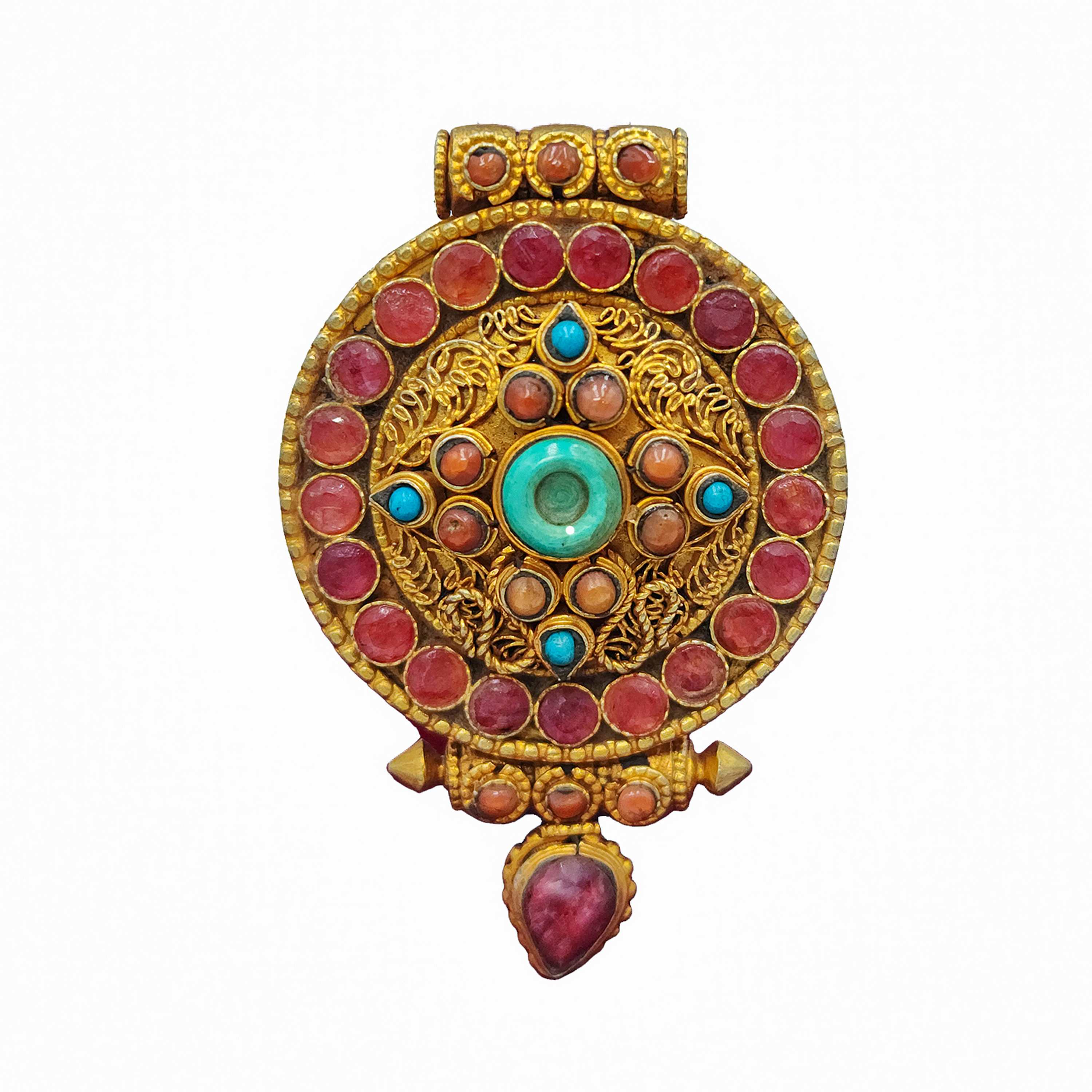Selling on ETSY discount
This discount is offered to ensure our prices remain highly competitive across all platforms, including Etsy. We aim to provide the best value for our customers, so we adjust our pricing to stay in line with market trends. By doing so, we continue to uphold our commitment to being the leading provider of high-quality Nepali handicrafts at the best prices.
Ghau
Ghau is a portable shrine in which an image of the owner's personal deity (Ishta Devata) is kept wrapped in silk cloth. Most Tibetans used Ghau at home and during traveling. At home, it is kept on alter but when traveling it is fastened at the cross belt. Generally, Ghau has trefoil shapes to and a window in the middle through which one can see the personal deity. Ghau is made of two parts which fit together to form a box. The back is usually left plain and the front is richly decorated.
Read More
Finishing: Stone Setting
The Ghau is adorned with an exquisite array of semi-precious stones, including turquoise, coral, and lapis lazuli. These stones are carefully selected and meticulously placed on the Ghau's surface, adding a touch of opulence and enhancing its overall beauty. Each stone is thoughtfully positioned using a high-quality adhesive, ensuring secure and long-lasting attachment. The vibrant colors and unique patterns of the stones create a captivating contrast against the backdrop of the Ghau, elevating its visual appeal and making it truly eye-catching.
Beyond their decorative purpose, these semi-precious stones carry symbolic significance in various cultures and traditions. Turquoise is often associated with protection and healing, coral represents vitality and passion, while lapis lazuli symbolizes wisdom and truth. The inclusion of these stones not only adds to the aesthetic allure of the Ghau but also imbues it with deeper meaning and cultural symbolism.
The intricate placement of these semi-precious stones showcases the meticulous craftsmanship and attention to detail that goes into the creation of the Ghau. It is a testament to the skill and artistic vision of the artisans who delicately adorn the statue, resulting in a truly remarkable and captivating piece of art.
Read More
What is Seku Desing
Seku is a traditional Newari craftsmanship technique that involves the use of thin metal wire, typically copper or silver, to create intricate patterns on various objects. The word "Seku" is derived from the Newari language, and is commonly used to refer to this type of craftsmanship. This technique is a prominent aspect of Newari art and has been passed down through generations of artisans.
The process of creating Seku designs involves carefully shaping and molding the metal wire into various patterns. This can include simple geometric shapes or more complex, detailed designs. The wire is then carefully placed onto the surface of the object, where it is secured in place. The final result is a beautiful and intricate design that showcases the skill and precision of the artisan.
Seku craftsmanship can be found on a variety of different objects, including traditional Newari jewelry, home decor, and even architectural elements. The technique is often used to add decorative touches to objects that are already rich in cultural significance, such as statues of deities and other religious artifacts. The intricate and detailed nature of the craftsmanship makes it highly valued and respected within the Newari community, and it continues to be an important aspect of their cultural heritage.
Read More
About Elector Gold Plating
The Ghau has been crafted using the ceramic mold casting process, a modern approach that provides an alternative to traditional methods such as the lost-wax system or rubber molding. Also referred to as ceramic molding, this technique involves the creation of a ceramic mold to cast the statue. The process begins by making a precise and detailed wax model of the desired sculpture. The wax model is then coated with layers of ceramic material, creating a sturdy mold. Once the mold is complete, it is fired in a kiln, causing the wax to melt and escape, leaving behind a cavity that perfectly replicates the original sculpture. Molten metal is then poured into the mold, allowing it to fill the cavity and take on the desired form. Once cooled and solidified, the ceramic mold is carefully broken away, revealing the final metal statue.
The process begins with the thorough cleaning and preparation of the object to be plated. A layer of silver plating is first applied to create a base. Subsequently, the object is submerged in a solution containing gold ions, while an electric current is passed through the solution. The gold ions are attracted to the surface of the object, forming a layer that can be polished to achieve a smooth and radiant finish.
The Full Electro Gold plated finishing offers several advantages, including affordability and high-quality results. In Nepal's handicraft industry, this method of gold plating is gaining popularity due to its ability to produce exquisite and long-lasting handicraft items. Skilled craftsmen employ their expertise to ensure that the gold plating is of the utmost quality, resulting in beautiful and durable Ghau products.
By choosing the Full Electro Gold plated finishing, you can enjoy the luxurious and captivating allure of gold, enhancing the aesthetic appeal of the Ghau product while ensuring its longevity and enduring beauty.
Read More
